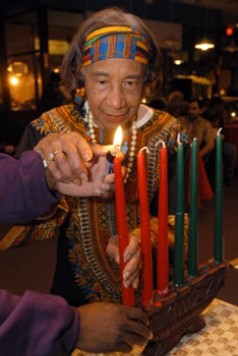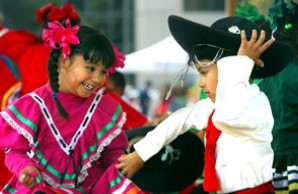
The American Cultural Tapestry
American Corner | 2013-01-31 11:45
To understand American behavior and public policies, it is essential to know the culture of the United States. In many languages culture usually refers to art, music, history, and literature. In the United States, these would be viewed as the results or artifacts of culture. Our defi nition of culture is much more anthropological.
In American English “culture” simply means the way of life of a group of people passed down from one generation to another through learning. It includes fundamental beliefs, values, thought patterns, and worldviews that are shared by most Americans. We can examine these external aspects of culture and infer that they refl ect our internal values, beliefs, and worldviews. Unless we understand American internal culture, it is almost impossible to explain external behavior, including our public policies.

Tina Solomon, 88, of Brockton, Massachusetts, lights a candle for the first night of Kwanzaa, an African-American holiday.
If we had to develop a graphic representation of the American dominant or mainstream culture, we might consider an iceberg. Most of an iceberg is under water and hidden. The same is true of culture. Most of it is internal or inside our heads and well below the water level of conscious awareness. While the visible tip may change—as an iceberg will melt with sun and rain—the base does not change very much over time. In the same way, one’s fundamental beliefs, values, ways of thinking, and worldviews change very slowly. This part of culture is learned unconsciously simply by growing up in a particular community or family. No parent sits down at the breakfast table with a child and teaches a lesson on “cultural values.” Rather they are learned unconsciously just by growing up in a particular family. This is the reason we are relatively unaware of our cultural values until we leave our country and interact with people of other cultures.
Emphasizing Individual Achievement
When immigrants fi rst arrived to America, they brought their European beliefs and values to the “New World.” They had landed in a place where there appeared to be unlimited natural resources and vast opportunities to excel. In Europe, if you were born poor you died poor. The combination of European beliefs and values and the abundant supply of resources and opportunities created a new set of cultural values that we call “American.”
These new beliefs and values of individual achievement and class mobility were rewarded and reinforced. Americans then began to identify themselves in terms of what they do. If you encounter an American at a party, he or she will often greet you with: “Hello, my name is Gary Weaver. I’m a professor at American University. What do you do?” People from many other cultures, however, identify themselves in terms of who they are. A West African might greet you by saying,
“Hello. I’m Pap Seka the son of Tamsier Seka from up river in Basse.” The primary source of his identity is who he is—his father and his birthplace. His status is based upon family and heritage, not what he does as an individual or what he may do in the future.
Distrust of an Overly Powerful Central Government
In contrast with the practices in Europe, the first settlers to come to the shores of America did not want a king, queen, or pope. They were very suspicious of an overly powerful central government. In the words of the great American philosopher Henry David Thoreau (1817-1862), they believed that “less government is better government.” Of course, they knew that their “New World” needed a national government to handle foreign affairs and international commerce; matters that impacted everyday life however were deemed the responsibility of local government.
America has never had a national police force. Issues of welfare, law enforcement and adjudication, care for the infirm, and so on, are matters of local jurisdiction. America’s civil liberties, such as free speech, freedom of the press, freedom of religion, and so on, are found in the Constitution and the Bill of Rights. These documents protect individual freedoms and defend against an overly powerful national government.
Not Quite a “Melting Pot”
Many people believe that the United States is a mixture of many different cultures without a dominant or mainstream culture. The metaphor often used to reflect this assumption is the “melting pot.” People from around the globe bring their cultures here and throw them into the American pot. The mixture is stirred and heated until the various cultures melt together.

Arleet Del Real (left), age 5, and Javier Acuna, age 6, dance with the Xochiquetzal-Tiqun Mexican dancers during the “Meet the World” event in Anchorage, Alaska.
There is some truth to this idea. The United States is certainly a culturally diverse society; however, there is also a dominant culture. Immigrants became a part of this culture by giving up many of their differences so that they could fit into the mainstream of society. Some would argue that the United States has often had a cultural “cookie-cutter” approach, with a white, Anglo-Saxon, Protestant, male mold or shape as the model. White immigrant males could easily fit such a mold by adopting an Anglo name, converting to Protestant Christianity, and speaking English without a foreign accent. However, not everyone could fit the cookie-cutter mold. People can’t change their gender, skin color, or hair texture. Some people melted more easily than others.
Share this page



















